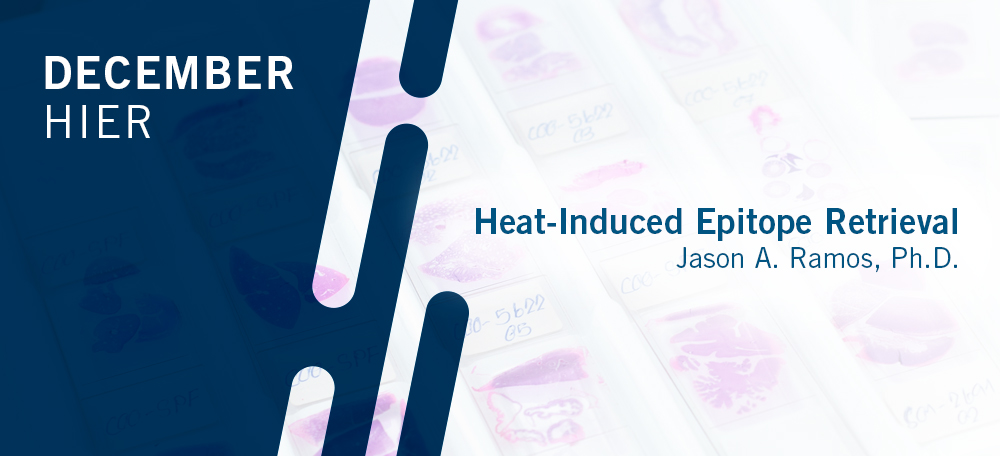
Introduction
Formalin has been used since 1893 as the standard fixative for tissue processing in histopathology.1 Due to formalin’s superior preservation of morphological detail, criteria for pathological diagnoses have been established through the observation of formalin-fixed, paraffin-embedded (FFPE) tissue sections stained with hematoxylin and eosin. Although many other fixatives exist, none have supplanted formalin in general use. Formalin is a cross-linking type of fixative, forming methylene bridges between proteins within the tissue.2,3 This cross-linking reaction adversely alters the structure of tissue proteins, resulting in loss of antigenicity.4 One way to restore antigenicity is through the use of heat-induced epitope retrieval (HIER) prior to immunohistochemistry (IHC).
The complexity of the IHC protocol demands a properly-trained, highly-skilled staff to achieve the most accurate, consistent diagnoses. As the enhanced diagnostic utility of IHC has been realized, an increased demand has been placed on the histology laboratory. Automation, and the concomitant standardization and reduction of variability, allows laboratories to achieve the quality, reproducibility, and speed necessary to meet the increased IHC demand.5
HIER
HIER, also known as Antigen Retrieval (AR), is based upon biochemical studies suggesting that the cross-linking reaction between protein and formalin may be reversed by high-temperature heating or strong alkaline hydrolysis.2,3,6 The routine use of HIER prior to IHC has been shown to minimize inconsistency and standardize staining.7-8 The most critical aspects that influence the quality of HIER results: 1) Heating temperature; 2) Heating time; and 3) The pH of the retrieval solution.
HIER is the process of heating the slide-mounted specimen material in an antigen retrieval solution, followed by a cooling-off period. There is no universal antigen retrieval solution available for restoring all antigens.9 The most commonly used antigen retrieval solutions are citrate-based, tris-based, or EDTA-based solutions.9-10 The pH of the HIER solution influences the immunohistochemistry staining intensity significantly and is critical to the effectiveness of HIER for the specific antigen tested.11 HIER at the appropriate pH allows the antigen to regain its natural shape. Some antigens retrieve better in a lower pH solution, such as a citrate buffer, while others will retrieve better in a higher pH solution, such as a tris buffer.9,11 The composition and the pH of retrieval buffers are critical for optimal retrieval and subsequent staining.
One mechanism to explain how HIER works is by hydrolysis of the methylene bridge cross-links.9,11,12,13,14 Breaking the formalin-induced methylene cross-links in the presence of the appropriate pH solution allows the fixed protein to undergo a series of conformational changes to restore, or partially restore, its native structure. The conformational change allows for better access for the antibody to bind to the antigen. The entire process is being driven by thermal energy from the heat source.11 It is hypothesized that the application of heat accelerates breakage of the methylene cross-links. Subsequently, the methylene cross-links get hydrolyzed when that energy threshold has been reached. The amount of energy added during HIER is determined by heating temperature as well as heating time. There is an inverse relationship between heating temperature and heating time: the higher the temperature, the shorter the heating time needed to attain optimal results. Heating at a higher temperature for a shorter duration yields better staining results than heating at a lower temperature for a longer time.9
The source of heat can be from any number of laboratory equipment, including: pressure cookers, steamers, water baths, microwave ovens, and fully automated IHC stainers. Using a laboratory pressure cooker eliminates the irregular heating and temperature variation/hot spots inherent to steamers and microwave ovens.9,10,13 Ultimately, the introduction of automated IHC staining platforms and online heat retrieval techniques solved much of the inconsistency problems encountered with the majority of other heat retrieval devices. Online HIER processes are more reproducible, less damaging to tissue sections, and save a great deal of time. One major attribute of automation is standardization of protocol and reducing variability from user to user with manual HIER and IHC staining processes.
Clinical References:
2. Fraenkel-Conrat H, Olcott HS. J Biol Chem. 1948 Jul;174(3):827-43.
3. Fraenkel-Conrat H, Olcott HS. J Am Chem Soc. 1948 Aug;70(8):2673-84.
4. Montero C. J Histochem Cytochem. 1991 Jun;39(6):741-8.
5. Prichard JW. Arch Pathol Lab Med. 2014 Dec;138(12):1578-82.
6. Shi S-R, Key ME, Kalra KL. J Histochem Cytochem. 2003 Jan;51(1):1-4.
7. Shi S-R, Cote RJ, Taylor CR. J Histotechnol. 1999 Sep;22(3):177-92.
8. Taylor CR, et al. Biotech Histochem. 1996 Jan;71(5):263-70.
9. Ramos-Vara JA, Miller MA. Vet Pathol. 2014 Jan;51(1):42-87.
10. Tacha D, Teixeira M. J Histotechnol. 2002 Dec;25(4):237-42.
11. Shi S-R, Cote RJ, Taylor CR. J Histochem Cytochem. 2001 Aug;49(8):931-7.
12. Guo T, et al. J Histochem Cytochem. 2007 Jul;55(7):763-72.
13. Van Hecke D. J Histotechnol. 2002 Mar;25(1):45-54.
14. Gown AM. Am J Clin Pathol. 2004 Feb;121(2):172-4.

